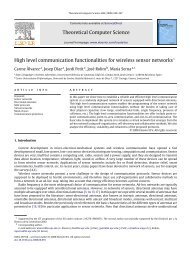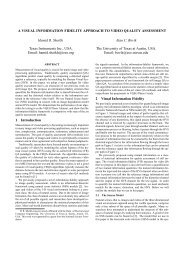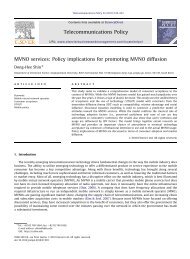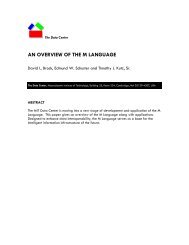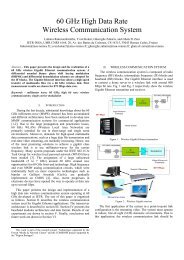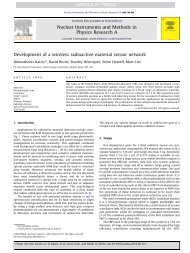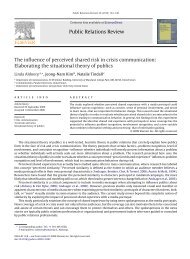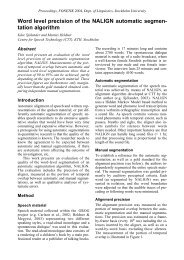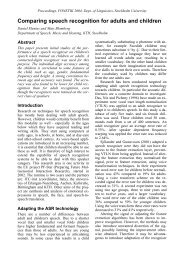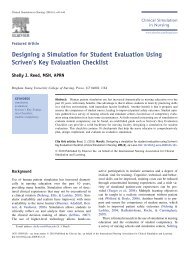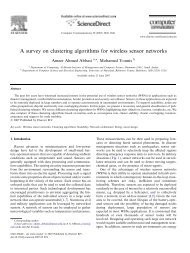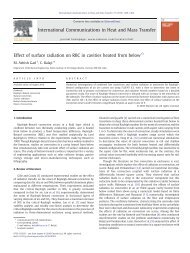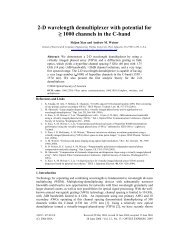BLR: beacon-less routing algorithm for mobile ad hoc networks
BLR: beacon-less routing algorithm for mobile ad hoc networks
BLR: beacon-less routing algorithm for mobile ad hoc networks
You also want an ePaper? Increase the reach of your titles
YUMPU automatically turns print PDFs into web optimized ePapers that Google loves.
1080<br />
bro<strong>ad</strong>casted at full transmission power, even in case the<br />
<strong>for</strong>warding node is located very close. There<strong>for</strong>e, the<br />
possible interference range is increased and inhibits other<br />
simultaneous transmissions in the vicinity. These two facts<br />
are a major source of energy consumption. Furthermore,<br />
bro<strong>ad</strong>cast packets are transmitted at 2 Mbps while unicast<br />
packets may be transmitted at 11 Mbps using IEEE 802.11b.<br />
In order to circumvent these drawbacks, an option in <strong>BLR</strong> is<br />
not to bro<strong>ad</strong>cast all data packet, but to transmit most of the<br />
packets via unicast with <strong>ad</strong>justed transmission power.<br />
After a node has detected through passive acknowledgment<br />
the successful reception of the transmitted packet,<br />
it is aware of the <strong>for</strong>warding node’s position. Thus, the node<br />
may <strong>ad</strong>just its transmission power and send the subsequent<br />
packets via unicast to the node, which relayed the bro<strong>ad</strong>cast<br />
packet. Due to the mobility of the nodes, a node located at a<br />
better position towards the destination may enter into the<br />
node’s transmission range. In order to be able to detect this<br />
new node, a packet is bro<strong>ad</strong>casted at full power again after a<br />
certain time called Beacon_Interval. After bro<strong>ad</strong>casting a<br />
packet at full power, new neighboring nodes may be<br />
detected. However, this restriction applies as well <strong>for</strong><br />
‘conventional’ <strong>beacon</strong>ing mechanisms, where a node<br />
located at a better position can only be detected after it<br />
announces its position by bro<strong>ad</strong>casting a <strong>beacon</strong>. Hence, an<br />
optimized <strong>routing</strong> path is determined after the <strong>beacon</strong><br />
interval.<br />
Packets transmitted via unicast are <strong>for</strong>warded immediately<br />
without introducing an <strong>ad</strong>ditional delay. Furthermore,<br />
unicast packets are explicitly acknowledged on the MAClayer.<br />
In case a node is no longer able to deliver packets via<br />
unicast because, e.g. the downstream node was switched off,<br />
it transmits the next packet again in bro<strong>ad</strong>cast mode to<br />
detect other nodes towards the destination. Similarly, if a<br />
node detects its downstream node to be moving out of its<br />
transmission range, a packet is transmitted at full power<br />
even be<strong>for</strong>e Beacon_Interval in order to avoid unnecessary<br />
interruptions of links with ongoing data transmissions.<br />
Velocity and direction of movement are stored in the packet<br />
to estimate time of link break.<br />
In order to reduce the delay in case the <strong>ad</strong>dressed unicast<br />
node is not reachable anymore, which would cause timeouts<br />
and retransmissions, nodes may operate in promiscuous<br />
mode, i.e. they process as well unicast packets, which are<br />
not destined <strong>for</strong> them. All nodes located in the <strong>for</strong>warding<br />
area, which detect that a unicast packet was not acknowledged<br />
or relayed within a certain time, assume that the<br />
unicast delivery failed and apply DFD as usual. There is a<br />
tr<strong>ad</strong>e-off with energy consumption, since operating nodes in<br />
promiscuous mode consumes a lot of battery power too.<br />
3.4. Aggregation of paths<br />
In order to be able to take <strong>ad</strong>vantage from transmitting<br />
unicast data packets, different paths through one node are<br />
aggregated. For that, each node keeps a table of all<br />
M. Heissenbüttel et al. / Computer Communications 27 (2004) 1076–1086<br />
neighboring nodes and their respective positions, which it<br />
gathered from overheard packets and passive acknowledgements.<br />
A node may <strong>for</strong>ward a packet via unicast inste<strong>ad</strong><br />
of bro<strong>ad</strong>casting as soon it is aware of any neighbor that is<br />
closer to the final destination. This can possibly le<strong>ad</strong> to a<br />
very suboptimal path since packets may be routed to distant<br />
nodes with little progress even if there are nodes located at<br />
much better positions. Another possibility to route the<br />
packet more directly towards the destination is to allow a<br />
node to transmit a packet only via unicast if the known<br />
neighbor is alre<strong>ad</strong>y located in the <strong>for</strong>warding area <strong>for</strong> that<br />
packet.<br />
3.5. Backup mode<br />
A node which does not detect through passive acknowledgement<br />
a <strong>for</strong>warding of data packets within Max_delay<br />
assumes an empty <strong>for</strong>warding area with no nodes. A<br />
recovery strategy is defined to deal with this situation. The<br />
node bro<strong>ad</strong>casts a short request and all neighboring nodes<br />
reply with a packet indicating their positions. If a node<br />
located closer to the destination replies, this node is chosen<br />
as the next hop. Otherwise, the actual node extracts a planar<br />
subgraph (e.g. Gabriel Graph) <strong>for</strong> its neighborhood and<br />
<strong>for</strong>wards the packet via unicast according to the right-hand<br />
rule (see e.g. AFR [15]). The extraction of the planar<br />
subgraph is necessary in order to prevent packets to enter a<br />
loop (actually this only applies <strong>for</strong> static <strong>networks</strong>). The<br />
position where the basic mode failed is stored in the packet<br />
he<strong>ad</strong>er. As soon as the packet arrives at a node located<br />
closer to the destination than where it entered the backup<br />
mode, it switches back to the basic greedy <strong>for</strong>warding again.<br />
3.6. Reactive local <strong>routing</strong> (RLR)<br />
In order to cope with inaccurate location in<strong>for</strong>mation, a<br />
reactive local <strong>routing</strong> <strong>algorithm</strong> (RLR) is applied in the<br />
vicinity of the destination. The reason <strong>for</strong> using a reactive<br />
protocol inste<strong>ad</strong> of a proactive as proposed in Terminodes<br />
Routing [14] is that proactive protocols require to transmit a<br />
list of neighbors in the <strong>beacon</strong>s. Especially in dense<br />
<strong>networks</strong> and with high transmission ranges, the number<br />
of neighbors can be large and hence significantly increase<br />
the size of the <strong>beacon</strong>s.<br />
RLR is initiated in case a node, other than the final<br />
destination node, which is within transmission range r of the<br />
destination coordinates, receives the packet and has no closer<br />
neighbor. RLR is a restricted and <strong>ad</strong>apted version of the<br />
standard AODV protocol [2]. The node bro<strong>ad</strong>casts six Route<br />
Requests (RREQs) <strong>for</strong> the final destination node with the<br />
destination coordinates of these RREQs in six directions<br />
separated by 608 and at twice the transmission range from the<br />
original destination coordinates. Thereby, the flooding and<br />
the propagation of the RREQs are limited. The destination<br />
node receives or at least overhears the RREQ and responds<br />
with a Route Reply (RREP). After the establishment of


